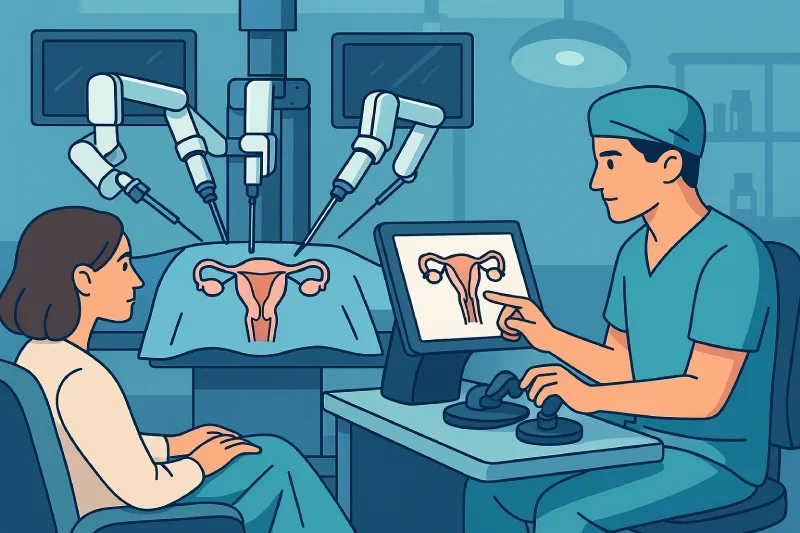Robotic Hysterectomy Scar Appearance and Healing
Categories:
By: Ethan Cole
Robotic hysterectomy has become a widely preferred surgical option for women requiring removal of the uterus due to conditions like fibroids, endometriosis, or abnormal bleeding. As a minimally invasive approach, it offers smaller incisions, faster recovery, and fewer complications than traditional open surgery.
One of the most common concerns patients have is what their scars will look like after the procedure. Because robotic hysterectomy is performed through several small abdominal incisions—rather than one large cut—the resulting scars are typically minimal, discreet, and fade significantly over time.
In this blog, we’ll walk you through everything you need to know about robotic hysterectomy scars: how they look right after surgery, what to expect during healing, how to care for them properly, and tips to minimize their long-term visibility. Whether you’re preparing for surgery or recovering now, this guide will help you understand and manage the healing process with confidence.
Key Takeaways
Robotic hysterectomy scars are small, discreet, and heal quickly. Initial redness fades within weeks, and most scars become barely noticeable by six months with proper care, sun protection, and guided recovery protocols.
Compared to open hysterectomy, robotic scars offer cosmetic advantages. Tiny incisions reduce scarring risks, lower infection likelihood, and provide patients with faster recovery while minimizing long-term aesthetic concerns and visible marks on the lower abdomen.
Healing after robotic hysterectomy follows a predictable timeline. Scars mature gradually, flatten, and lighten in color within months, with full fading dependent on genetics, age, skin type, and adherence to scar care.
Risk factors for raised or keloid scars exist. These include genetics, darker skin pigmentation, wound infection, and tension on healing incisions, making individualized care and monitoring critical to achieving optimal scar appearance outcomes.
Proper scar management improves healing and appearance. Using silicone gels or sheets, moisturizing, and protecting against sun exposure help scars soften, fade, and remain discreet throughout the recovery and healing process.
Internal recovery is as important as external scar healing. While skin incisions fade early, tissues like the vaginal cuff heal over several weeks, impacting overall comfort, strength, and long-term surgical recovery outcomes.
What Is a Robotic Hysterectomy?
A robotic hysterectomy is a minimally invasive surgical procedure in which the uterus is removed using robotic-assisted technology. This technique is commonly used to treat conditions such as uterine fibroids, endometriosis, abnormal bleeding, uterine prolapse, or certain gynecologic cancers. Unlike open abdominal surgery, which requires a large incision, robotic hysterectomy is performed through several small incisions in the lower abdomen.
Typically, the procedure involves three to five incisions, each measuring about one centimeter. These are used to insert the robotic instruments and a camera, which gives the surgeon a magnified, high-definition, 3D view of the pelvic area. From a nearby console, the surgeon controls robotic arms that provide enhanced precision, flexibility, and stability.
Because of its minimally invasive nature, robotic hysterectomy offers key benefits such as less pain, reduced blood loss, faster recovery, and—most relevant to this article—smaller, less noticeable scars compared to traditional surgical approaches.
What Do Robotic Hysterectomy Scars Look Like?
One of the most noticeable differences between robotic and traditional hysterectomy techniques is the appearance and location of the surgical scars. Robotic hysterectomy is designed to be as minimally invasive as possible, and that translates to smaller, less prominent scars that typically fade with time.
Initial Appearance of Scars
In the first few days and weeks after surgery, the incisions may appear red, pink, or slightly raised. They are typically closed with surgical glue or dissolvable sutures, and may be covered with small adhesive strips. Mild swelling and tenderness are normal during the early healing phase.
Scar Location and Size
Robotic hysterectomy typically involves three to five small incisions in the lower abdomen. These are each about 0.5 to 1 centimeter in length and are commonly placed:
Around or just below the belly button (umbilical port)
Along the bikini line
On either side of the lower abdomen
The precise location depends on your anatomy and the surgeon’s technique, but all incisions are placed strategically to be as discreet as possible.
How Scars Change Over Time
Over several weeks to months, scars generally flatten and change color—from red or pink to a lighter skin tone. Most patients find that, by 3 to 6 months post-op, the scars are barely noticeable. In individuals with darker skin, scars may appear hyperpigmented for longer before fading. Good scar care and sun protection can help improve cosmetic outcomes.
Robotic vs. Open and Laparoscopic Scars
Compared to traditional open hysterectomy, which typically involves a large incision across the lower abdomen, robotic hysterectomy scars are significantly smaller and less visible. Even compared to standard laparoscopy, robotic procedures often involve more precise incision placement, which may further minimize visible scarring.
Scar Healing Timeline After Robotic Surgery
The healing process after robotic hysterectomy is gradual but predictable. While everyone heals at a slightly different pace, most patients follow a consistent timeline in terms of how the incisions close, how the scars look, and when they begin to fade. Understanding these phases can help set expectations and reduce anxiety about your recovery.
Week 1 – Early Healing
During the first week, the surgical incisions begin to close and form scabs. Redness, slight swelling, and mild tenderness are common. The area should be kept clean and dry, and you should avoid heavy lifting or any movement that strains the abdominal area. Your doctor may advise wearing loose-fitting clothing and checking the wounds daily for signs of infection.
Weeks 2–4 – Reduced Redness and Sensitivity
By the second or third week, the incisions are typically sealed. Any scabs begin to fall off naturally, and the redness may start to fade slightly. Some itching or tightness around the scar area is normal. At this stage, you might be cleared to apply gentle moisturizers or begin light scar care, as advised by your surgeon.
Months 1–6+ – Scar Maturation
Over the following months, the scars gradually flatten, soften, and become less visible. The color fades from pink or red to a lighter, more skin-toned appearance. Most robotic hysterectomy scars become barely noticeable by the 6-month mark. However, individual results can vary depending on skin type, age, genetics, and post-op care.
Scar Healing Timeline Overview
|
Time Frame |
Scar Appearance & Sensation |
Recommended Care |
|
Week 1 |
Red, slightly swollen, tender |
Keep clean and dry; no lifting |
|
Weeks 2–4 |
Less redness, sealed, mild itching |
Gentle washing, begin scar care |
|
1–3 Months |
Fading color, flatter, softening |
Sun protection, moisturize |
|
3–6+ Months |
Pale or skin-toned, minimal visibility |
Optional silicone treatments, monitor |
Recovery and Scar Care After Robotic Hysterectomy
Healing after robotic hysterectomy is typically faster and less painful than traditional surgery, but proper care during recovery is essential—especially when it comes to managing incisions and minimizing scars. Following your surgeon’s instructions can help ensure your scars heal cleanly and fade well over time.
General Recovery Timeline
Most patients are able to walk within a day of surgery and return to non-strenuous activities within 7 to 10 days. Driving, working at a desk job, or light housework may resume within two weeks. Full recovery—including internal healing—may take four to six weeks.
Heavy lifting, high-impact exercise, and sexual activity are usually restricted during the early recovery phase. Always get your doctor’s clearance before returning to these activities.
Common Postoperative Symptoms
It’s normal to experience mild abdominal discomfort, bloating, and fatigue during the first week. Some patients also feel shoulder pain due to residual carbon dioxide gas used during laparoscopic surgery. These symptoms usually subside within a few days.
The incision sites may feel tight, itchy, or slightly sore—but should not ooze pus, become excessively red, or cause increasing pain. If they do, consult your surgeon promptly.
Incision and Scar Care Instructions
Keep incisions dry for the first few days; sponge baths may be recommended early on
Once cleared by your doctor, gently wash the area with mild soap and water—avoid scrubbing
Pat dry with a clean towel and avoid tight clothing that rubs against incisions
Do not apply lotions, ointments, or scar products unless approved by your provider
Avoid sun exposure on the scar area; use SPF if incisions are exposed to sunlight
With consistent care, robotic hysterectomy scars tend to heal well and become barely noticeable in the long term.
Tips to Minimize Scar Visibility
Although robotic hysterectomy scars are already small and discreet, proper aftercare can further reduce their appearance over time. Below are essential tips to help promote smooth, well-healed scars and avoid complications that may affect cosmetic outcomes.
Follow Your Surgeon’s Post-Op Care Instructions
Your doctor will give you specific instructions about incision care, activity restrictions, and when to resume certain tasks. Adhering closely to this guidance is the most important way to avoid delayed healing or complications that could lead to visible scarring.
Keep the Incision Clean and Dry Early On
During the first few days after surgery, it’s important to protect the incisions from moisture, sweat, and bacteria. Clean them gently (when advised) and allow the skin to breathe. Avoid using creams, oils, or ointments unless explicitly approved by your surgeon.
Avoid Sun Exposure to Healing Scars
UV rays can darken healing skin and lead to more noticeable scars—especially in patients with medium to darker skin tones. Keep scars covered, or apply broad-spectrum sunscreen (SPF 30 or higher) once the area is fully closed and healed.
Consider Silicone Gels or Sheets
Silicone-based products can help flatten, soften, and fade scars over time. Once your incisions are completely healed and closed, you may ask your doctor whether silicone sheets or gel is appropriate. These are often used for both cosmetic and medical scar management.
Monitor for Abnormal Scarring or Infection
Some patients are more prone to developing hypertrophic or keloid scars, which are raised and can become itchy or tender. Signs of infection (pus, increased redness, heat, or pain) also warrant immediate medical attention. Early treatment can prevent complications and reduce the risk of long-term scarring.
Conclusion
Robotic hysterectomy offers not only medical precision but also aesthetic advantages, particularly when it comes to scar appearance. With small, well-placed incisions and advanced surgical control, most patients experience minimal scarring that fades significantly over time. Compared to traditional open surgery, the cosmetic benefits are substantial—allowing many women to feel more confident during and after recovery.
As with any surgical procedure, proper post-operative care is essential. Following your surgeon’s guidance, protecting healing skin, and monitoring for any unusual changes can all contribute to better long-term scar outcomes.
Dr. Jason Neef, a leading expert in robotic gynecologic surgery, emphasizes the importance of both technical precision and patient-centered recovery. If you’re considering hysterectomy or have questions about scarring and healing, Dr. Neef and his team are here to help you make the most informed, confident decision for your health.
Restore confidence with advanced robotic hysterectomy care.
Call (817) 568-8731Categories:
Frequently Asked Questions
-
Robotic hysterectomy incisions are small, about 1 cm each, usually five tiny cuts on the lower abdomen. They start red or pink and gradually fade over weeks to months.
-
Most scars begin fading from red or pink to skin tone within 4–6 weeks. Full fading and softening may take several months with consistent aftercare and sun protection.
-
Genetics, darker skin tones, wound infection, prolonged inflammation, and incision tension increase risk. Careful wound care and early scar management can help reduce hypertrophic or keloid scarring.
-
Robotic scars are far smaller, heal faster, and are less visible compared to the large abdominal incision of open hysterectomy, which carries a higher risk of prominent scarring.
-
Silicone gels, silicone sheets, daily moisturizing, and sun protection are first-line options. Advanced treatments like steroid injections or laser therapy may help persistent scars.
-
Incision pain is usually mild and controlled with over-the-counter medication. Most discomfort is linked more to internal healing than the small skin incisions.
-
Most patients resume light daily activity within 2 weeks and return to exercise or heavier tasks by 4–6 weeks, depending on their surgeon’s guidance and recovery progress.
-
The infection risk is low, but incisions should be kept clean and dry. Following wound care instructions helps prevent complications and ensures smoother healing.
-
External incisions often look healed before internal tissues are fully recovered. Healing of the vaginal cuff and deeper structures continues for weeks, influencing comfort and overall recovery.
-
Post-op visits check incision healing, monitor internal recovery, and detect complications early. Following surgeon advice on wound care and activity restrictions ensures optimal scar outcomes.











